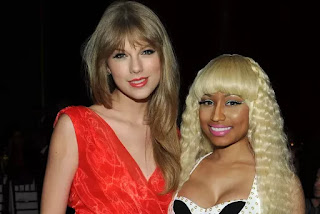On Wednesday, July 29th, the Stowe Center presented the fifth consecutive Stowe Salon at Lunch program. This week's topic focused on race in popular culture. Inspired by the recent episode, or some may say feud, between Taylor Swift and Nicki Minaj concerning Minaj's omission from the Video Music Awards "Best Video of the Year" award, the discussion predicated on general questions of "who is celebrated in popular culture?" and "who is represented in popular culture?"
Participants discussed the ways in which award shows and the commercial industry surrounding mediums of pop culture celebrate certain identities and body types, namely white, thin bodies.
Taylor Swift and Nicki Minaj via Getty Images
One participant offered a historical perspective on issues of race in popular culture, arguing that the media, whether music, television, film, or books, has long been a tool to reaffirm the status-quo and maintain a social hierarchy where white people are privileged and people of color are not. Depictions of people of color in popular culture, created often by large, corporate entities, thus occupy reductive, stereotypical representations as to maintain a narrative of white supremacy. The participant went on to explain that within this media culture many artists of color will also conform to the status-quo and engage in representations that are stereotypical out of necessity or a desire for fame and popular acceptance.
Other participants offered that in the 1960s and 1970s black musicians and musical groups were the most popular of the day, and that perhaps a situation like that between Taylor Swift and Nicki Minaj would not have happened. Another participant offered elaboration on this point, explaining that though black culture has always been popular in America, black people, whether in the '60s or today, have been subjugated to unfair and racist policies and actions.
August 2015 Ebony Magazine cover
Several participants lamented on the supposed negativity of the conversation. That music and popular culture at large should be a tool for unity, peace, and progress, seems to have been lost. Yet others offered a different perspective. Participants argued that critical analysis of popular culture can be an effective tool for understanding the world around us.
What are your thoughts on the depiction and representation of race in popular culture? What do you think of the Ebony cover? Continue the conversation in the comments!
Join us next week on August 5th for another Stowe Salon at Lunch on the topic of voting rights. Check out this article from New York Times Magazine on the evolution of voting rights since the Voting Rights Act was signed into law 50 years ago. Is the vote still open and accessible? Join us to discuss!
Join us next week on August 5th for another Stowe Salon at Lunch on the topic of voting rights. Check out this article from New York Times Magazine on the evolution of voting rights since the Voting Rights Act was signed into law 50 years ago. Is the vote still open and accessible? Join us to discuss!



No comments:
Post a Comment